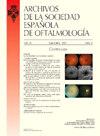Reporte de un caso: Raro caso de ciclodiálisis después de una cirugía de catarata manejado exclusivamente con terapia médica
Q3 Medicine
Archivos De La Sociedad Espanola De Oftalmologia
Pub Date : 2024-10-01
DOI:10.1016/j.oftal.2024.04.013
引用次数: 0
Abstract
We present the case of a 68-year-old female who presented with a substantial cyclodialysis after phacoemulsification identified by anterior segment optical coherence tomography and ultrasound biomicroscopy. Gonioscopy is challenging because of its shallow anterior chamber. Due to lack of response to topical steroids and refusal by the patient for surgical treatment, topical steroids were tapered, and cycloplegic was initiated. After 2 weeks, the cyclodialysis cleft was closed on optical coherence tomography persisting residual subchoroidal fluid, topical treatment was mantained. Despite of this, visual acuity and hypotony were restored. Finally at 2 months visit subchoroidal fluid was reabsorbed and patient was discharged.
Clinics should consider the possibility of cyclodialysis in cases of unjustified hypotony during postoperative period. In addition, we recommend performing anterior segment imaging which includes ultrasound biomicroscopy and optical coherence tomography, when the evaluation of angular structures is unfeasible. Finally, we propose medical management for severe cyclodialysis as the first option considering anti-inflammatory drugs could perpetrate the separation between scleral spur and ciliary muscle.
病例报告:罕见的白内障手术后循环透析病例,完全采用药物治疗
我们介绍了一例 68 岁女性的病例,她在接受超声乳化术后出现了大量的环状渗出,经前节光学相干断层扫描和超声生物显微镜检查发现了这一情况。由于前房较浅,巩膜镜检查具有挑战性。由于对局部类固醇缺乏反应,患者又拒绝手术治疗,因此局部类固醇逐渐减少,并开始使用环磷酰胺。2 周后,光学相干断层扫描显示环形透析裂隙闭合,但仍有残留的脉络膜下积液,患者继续接受局部治疗。尽管如此,患者的视力和眼底仍得到了恢复。最后,在 2 个月的回访中,脉络膜下积液被重新吸收,患者康复出院。此外,如果无法评估角膜结构,我们建议进行眼前节成像,包括超声生物显微镜和光学相干断层扫描。最后,考虑到抗炎药物可能会导致巩膜骨刺和睫状肌之间的分离,我们建议首选药物治疗严重的环状渗出。
本文章由计算机程序翻译,如有差异,请以英文原文为准。
求助全文
约1分钟内获得全文
求助全文
来源期刊

Archivos De La Sociedad Espanola De Oftalmologia
Medicine-Ophthalmology
CiteScore
1.20
自引率
0.00%
发文量
109
审稿时长
78 days
期刊介绍:
La revista Archivos de la Sociedad Española de Oftalmología, editada mensualmente por la propia Sociedad, tiene como objetivo publicar trabajos de investigación básica y clínica como artículos originales; casos clínicos, innovaciones técnicas y correlaciones clinicopatológicas en forma de comunicaciones cortas; editoriales; revisiones; cartas al editor; comentarios de libros; información de eventos; noticias personales y anuncios comerciales, así como trabajos de temas históricos y motivos inconográficos relacionados con la Oftalmología. El título abreviado es Arch Soc Esp Oftalmol, y debe ser utilizado en bibliografías, notas a pie de página y referencias bibliográficas.
 求助内容:
求助内容: 应助结果提醒方式:
应助结果提醒方式:


